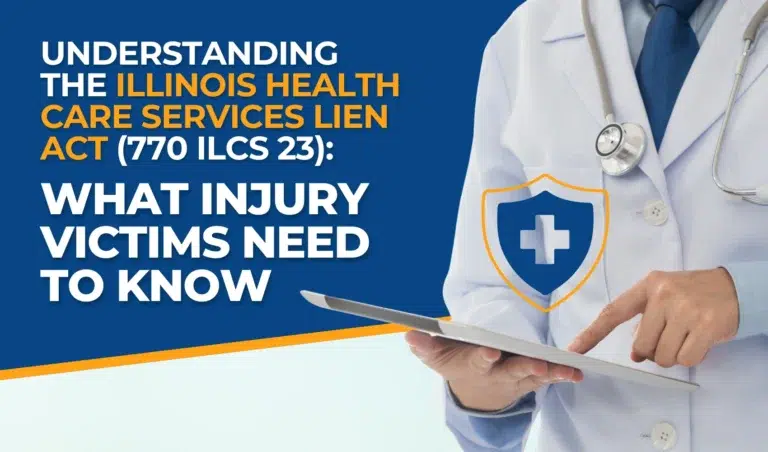When you’ve been injured and receive medical treatment, those bills don’t simply disappear while your personal injury case is pending. In Illinois, medical providers have a legal tool they can use to protect their right to payment: it’s called the Health Care Services Lien Act, codified under 770 ILCS 23. This law allows hospitals, doctors, and other health care professionals to place a lien on your potential settlement or judgment. That means they may be entitled to a portion of any compensation you recover, before you receive your portion.
Understanding how this law works is an important part of protecting your financial recovery. In this article, we’ll walk through the key provisions of the Illinois Health Care Services Lien Act, how liens are filed and enforced, and what it means for you as someone pursuing a personal injury claim.
Overview of the Illinois Health Care Services Lien Act
The Illinois Health Care Services Lien Act allows licensed health care professionals and providers to assert a lien against any judgment, award, settlement, or compromise obtained by an injured person in connection with a personal injury claim. This lien is intended to secure payment for reasonable charges related to medical care and treatment provided as a result of the injury.
Covered providers may include physicians, hospitals, clinics, physical therapists, and other licensed health care facilities. The lien attaches to the injured person’s claim and must be satisfied out of any recovery before the funds are distributed to the injured party. However, the Act does not apply to medical services provided under the Illinois Workers’ Compensation Act or the Workers’ Occupational Diseases Act. Those types of claims follow a separate process for resolving medical expenses.
To be valid, a lien must meet specific requirements under the law, including proper service of written notice to the injured party and all parties against whom the claim is asserted. The lien amount must also fall within statutory limits, which cap the total amount that can be claimed from a settlement or judgment. These provisions are designed to balance the rights of health care providers with the injured person’s right to recover fair compensation.
- Lien Limits and Distribution
The Illinois Health Care Services Lien Act imposes strict limits on how much of an injured party’s recovery can be claimed by health care providers through liens. These limits are designed to protect the injured person from having their entire settlement consumed by medical bills while still allowing providers a fair opportunity to recover reasonable charges. - Total Lien Cap
Under the Act, the combined total of all health care liens cannot exceed 40% of the total amount recovered, whether through a verdict, judgment, award, settlement, or compromise. This cap ensures that a substantial portion of the injured party’s recovery remains available for other expenses, such as legal fees and personal compensation. - Individual Provider Limits
No single category of health care provider may claim more than one-third of the total recovery. For example, if both a hospital and a treating physician assert liens, each is limited to no more than approximately 33.33% of the overall amount recovered. This rule prevents any one provider group from taking a disproportionate share and promotes balance among different types of lienholders. - Pro Rata Distribution
When the total liens exceed the statutory 40% cap, the Act requires that all lienholders share in the available amount on a pro rata basis. This means each provider receives a proportionate share of the available funds, rather than allowing the first in line to collect in full. Pro rata distribution ensures that the settlement is divided fairly among all valid lienholders, in accordance with the statutory limitations.
Notice Requirement
To enforce a lien, a health care provider must serve a written notice containing:
- The injured person’s name and address
- Date of injury
- Provider’s name and address
- Name of the party alleged to be liable
This notice must be served on both the injured person and the liable party, either in person or via registered/certified mail.
Relevant Case Law

Burrell v. Southern Truss (1997)
- The Illinois Supreme Court held that the Hospital Lien Act and the Physicians Lien Act provide for separate liens, each limited to one-third of the plaintiff’s settlement. This decision ensures that the combined liens do not consume the entire settlement, preserving a portion for the injured party.
Wendling v. Southern Illinois Hospital Services (2011)
- The court ruled that the common fund doctrine does not apply to liens under the Health Care Services Lien Act. Therefore, health care providers are not required to contribute to attorney’s fees from the settlement proceeds.
Practical Example
Consider a personal injury settlement of $100,000:
- Total Health Care Liens: Capped at $40,000, or 40% of the settlement
- Individual Provider Limit: No single category of provider (e.g., hospitals or physicians) may claim more than $33,333.33, or one-third of the total recovery
- Remaining for Plaintiff: At least $60,000, assuming there are no deductions for attorney’s fees, case costs, or other liens
Now imagine the injured party received care from two provider categories — a hospital with a $30,000 bill and a physician group with a $25,000 bill. Combined, these total $55,000, which exceeds the 40% cap. Under the Act, the providers must reduce their claims proportionally to fit within the $40,000 total cap.
Here’s how that would break down:
- Hospital (original lien: $30,000) → Receives approximately $21,818
- Physicians (original lien: $25,000) → Receives approximately $18,182
This pro rata distribution ensures that both providers share the available lien funds fairly and within legal limits, while preserving the plaintiff’s right to retain a substantial portion of the settlement.

Key Takeaways
- Lien Cap: Total health care liens cannot exceed 40% of the settlement.
- Provider Limited: No single provider category can claim more than one-third of the settlement.
- Notice: Proper written notice is required to enforce a lien.
- Common Fund Doctrine: Does not apply to health care liens under this Act.
Navigating the Illinois Health Care Services Lien Act can be a complex process, particularly when multiple providers are involved or when the total liens approach the statutory limits. Understanding how these rules work is essential to protecting your financial recovery and ensuring that your medical providers are paid fairly within the framework of the law.
If you’ve been injured and are pursuing a personal injury claim, speaking with an attorney can help you better understand how medical liens may affect your case. At Gosuits, we use proprietary technology to streamline case management and help clients stay informed throughout the process. Legal support can make a meaningful difference when it comes to negotiating liens and maximizing your net recovery—particularly when significant medical bills are involved.






